SMSL DO200 MKII Review
In this review, we test the SMSL DO200 MKII which is a dual ES9068AS balanced desktop DAC with DSD512, Bluetooth LDAC, and MQA support. It is priced at $469.
Disclaimer: This sample was sent to us for our honest opinion. Headfonics is an independent website with no affiliate links or partnerships. We thank Aoshida Audio and SMSL for their support.
Click here to learn more about SMSL products that we have previously featured on Headfonics.
Note, that this 2-page article follows our latest scoring guidelines which you can find in more detail here.
It is almost impossible now to predict what SMSL has in store next. The Chinese audio manufacturer is notoriously fast in releasing new products and revisiting popular and successful ones for a yearly update.
Remember our review of the SU-9 and M500 MKII DACs? Time does fly fast, and those keeping tabs will know that both the SU-9 and M500 series are already in their third version.
I briefly brought that up simply because in the years that those two unit series progressed and matured, a clear line can be seen on why the newer release should be considered. In having the same expectation with the DO200 MKII, it is quite surprising how little has changed.
Without the original DO200 on hand to listen to alongside this latest revision from SMSL, I cannot comment on what changed in that regard. I can at least share with you if the DO200 MKII has the meat to remain sitting pretty with its newer brothers.
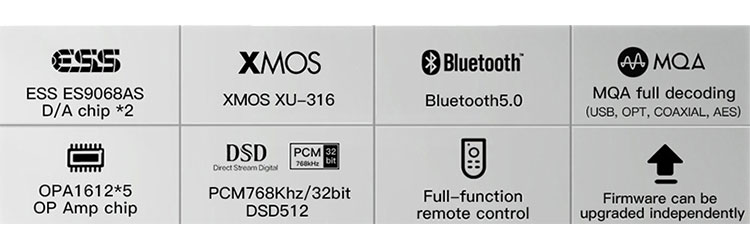
TECH HIGHLIGHTS
A complete mirror of the DO200’s numbers, it is a first for me to see a DAC from SMSL without the usual performance enhancements on its website.
While some may argue that the figures have become so low that they’re practically inaudible at that point, it is still exciting to know that your shiny new gear is a departure from the previous.
Instead, SMSL likes to bring your attention to the two key changes they installed. One is the newer XU-316 USB module from XMOS, then there’s the improvement of the UI coming from the new full-view IPS display.
I have to say though, while the modifications could be easy to dismiss for those chasing numbers, new buyers will appreciate that they now have access to a DAC that won’t feel out of place with newer members of the SMSL family.
And, with two ES9068AS DAC chips, a THD+N of -122dB, and MQA decoding capability, we have to remember that the DO200 MKII alone is one serious DAC. Add to this that the analog side is still comprised of five dual OPA1612A op-amps, and the circuitry is fed with electricity from a discrete power supply for lower noise.

DESIGN
Minus the updated IPS display, everything from the DO200 right down to its 1.2kg weight has been carried over to the DO200 MKII chassis. It will surely look right at home sitting squarely on top of the HO200 headphone amplifier
Everything about the three-piece frame assembly held together by four visible screws in the front and a couple more at the back is positively solid and premium-looking.
Touching the unit itself, there are no sharp edges around but I noticed that the main aluminum chassis in the middle is finished subtly rougher than the front plate where the volume and display are.
The volume knob is done with silver chamfering and is the only way to interface with the unit if the remote is missing. As a crucial part of the experience, I appreciate that it has the right amount of feedback when clicking into place and is very quick to turn with minimal play.
Covered in tempered glass, the new IPS display gorgeously adorns the DO200 MKII. With a responsive UI, clear texts, and variable brightness, reading the information on the screen won’t pose a problem.

I/O
For a device that by function commits to converting digital signals, one of the most important advantages one can carry is accessibility with input connections. The DO200 MKII is just that as it follows the same long list of inputs the original DO200 had.
It covers the basics of the price point such as USB-B, Bluetooth, optical, and coaxial inputs for the majority of audio enthusiasts, followed by AES/EBU and I2S input options because why not.
The only omission here when compared to the original DO200 is the extra USB-C input for service and firmware upgrades which used to hide beneath its USB-B input.
Right next to the inputs are the gold-plated output jacks to complete the picture. With two DAC chips inside of the DO200 MKII, it is obvious that with the size and shape of the unit, complementing a pair of single-ended RCA outputs is two full-sized 3-pin XLR for balanced connections.
Pairing the 4Vrms XLR sockets to a compatible amplifier or powered speakers, SMSL made sure that the DO200 MKII remains an impressive companion achieving the same 129dB dynamic range as the DO200. RCA users shouldn’t feel left out since it also measured at a very close 125dB dynamic range.
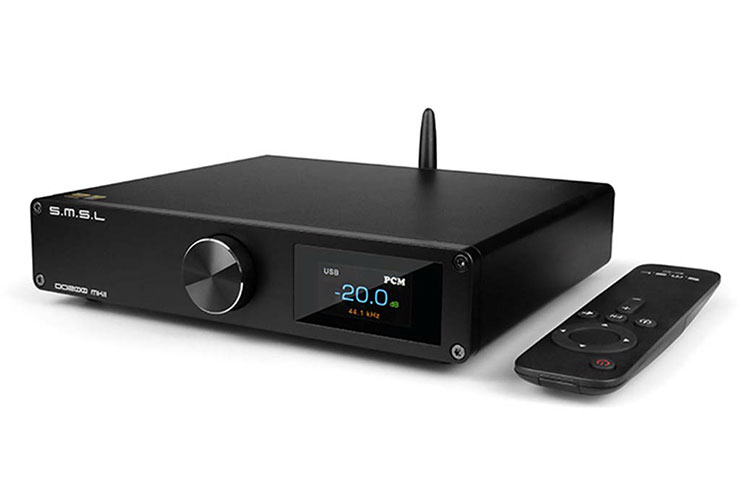
CONTROL
Briefly turning to the back of the DO200 MKII while first inspecting the unit, I quickly noticed the presence of a proper on-and-off switch which in my book is a plus for safety.
Some may find it inconvenient to always unplug the machine so having this feature means the unit can be completely shut off after a long press of the volume knob or by using the remote has placed it on standby.
Firing up, the DO200 MKII briefly showed the SMSL logo in the center of its vivid display which quickly changed to show the basic set of information the user needed.
Having a digital volume control, what can be read prominently in the center is the volume setting which can be altered from 0dB at the highest going all the way down to -99.5dB in 0.5dB increments.
Once the DAC correctly received an input connection, which in my case is USB, the DO200 MKII conveniently detects and displays the type of music playing and at what sample rate. This means that there is no extra step to enable MQA decoding as the DAC will tell in the display if an MQA file is fed.
All that so far is still talking about the surface-level controls of the DO200 MKII. Once you’ve become comfortable with it, don’t be shy to dig into the settings menu and see the host of things you can change baked into the system. Yes, there’s a lot.
Having the same UI/UX as the more expensive SU-10, it has the familiar SMSL layout for the settings menu and its sub-sections which makes personalizing the DO200 MKII look easy. If I’m correct the only thing separating the two for whatever reason is that not all settings are parallel on both.
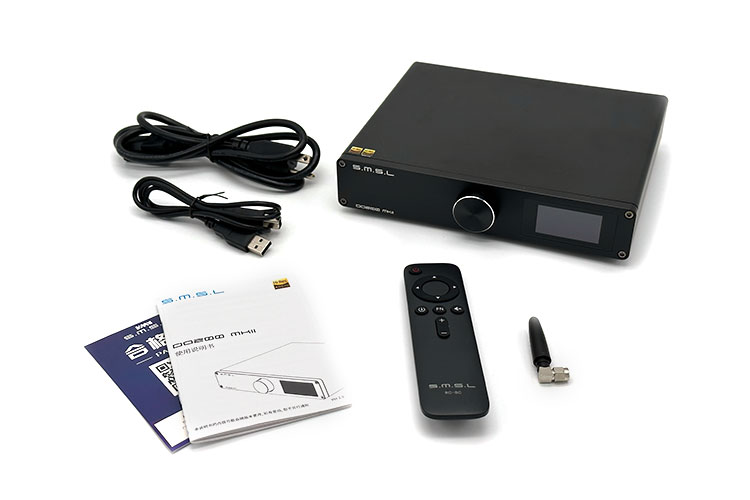
PACKAGING & ACCESSORIES
I don’t know what I was expecting but when the DO200 MKII arrived I was pleased to see a sure-looking bundle trying to impress.
What I mean is that while it is still not yet the modern black design seen in the SU-10, the size, and build of the box won’t let you feel left out noting that even with the smaller footprint of the DO200 MKII inside, the volumetric capacity of both is almost identical.
Continuing with the similarity from another SMSL DAC, the DO200 MKII is also kept in a jacketed presentation which reminded me of the SU-9 Pro. As I mentioned in the SU-9 Pro review, the sheath’s design is the same on two opposing sides which makes it confusing which is the true top.
Once you get inside, if you’ve owned or seen SMSL gear before, there will be no surprises here. Aside from the thick foam lining protecting the items, arranged neatly are the DAC itself, some paper works, and finally, the accessories included.
And to briefly cover the basic accessories provided, there is a standard power cable, USB cable, Bluetooth antenna, and remote control. But then again, if you’ve seen an SMSL review before, none of the add-ons listed has changed.
SOUND IMPRESSIONS
SUMMARY
Is there anything magical with the DO200 MKII? Having no history with the first release, I went in blind with the review but after using it for quite a while it is the overall honesty placed with a trace of midrange lushness that elevates the experience for me.
The DO200 MKII has a good baseline tonal balance that keeps it cool and if not for some minor hotness in the upper midrange. I’ll leave the tweaking to end-users though since there are built-in sound profiles to tune the DO200 MKII more personally.
I am putting the timbre as the crucial piece to the puzzle since measurements may have wowed owners before but in its current form, the resolution and dynamics leave me a bit wanting.
Not that it should shake into hiding when around similarly priced peers, but asking the DO200 MKII to take on some challenging tracks, does show some lack of delicateness in key areas.
TIMBRE
Knowing SMSL, the relaxed and very clean-sounding plucking of the guitar made me realize there may be more to the DO200 MKII. It has a mild sweetness to it that isn’t skewed far from linearity and is just ever so slightly more enjoyable to listen to especially on acoustic tracks.
This is good since I know the DO200 MKII is not a boring number-cruncher machine. So, while it will remind you on occasions of its balanced personality, the midrange at least is careful to not end up thin and hurried.
Expect to hear dry thumping kick drums playing modestly in a duet to the somewhat lush vocal timbre. What could better complete the scene tough is more tightness and texture to delineate properly the bass strings that don’t get enough bite.
Going back, voices aren’t sent too far or too close and it plays well with the rest of the instruments. Females also have a smooth flow that will show skill with vibrato and rougher edges.
Once it picks up to the shoutier portions of the song, I’m sometimes juddered when I hear a peak that is more thinly articulated than the rest. While it is not yet quite sibilant, the change in timbre is what makes it rough.
Listening closely to an isolated electric guitar riff from a busy rock song, the attack is there but the edges tend to gather, consequently crowding the clarity. Horns on the other hand are huge sounding and retain the expected brassy sound.
STAGING & DYNAMICS
Another talent the DO200 MKII has that I’ve been keeping a secret thus far is that it is doing a great job of picking apart naturally staged music. As I was playing some tracks to test, the distinctness of each instrument lets me focus on an object and easily place it in space.
Those who’re looking for a more natural or airy DAC though may find it a bit too exacting since it doesn’t have the same borderless and ethereal qualities my Burson Conductor 3 Reference gives to the same track. It could use a little more relaxation to not make subtle guitars and chimes playing in the background sound too rigid.
Staging width and depth are pretty even and while it is not the farthest should be far enough for most users. I find that the detail enjoys a bit of a boost since far objects don’t need to fight too hard to be heard.
SYNERGY
I fed the DO200 MKII to both my Burson Conductor 3 Reference and the EarMen CH-Amp to be able to get a real score of what it brings to the table. Being a relatively competitive DAC, the performance of the DO200 MKII did not feel too left out but for the experienced listeners out there, it’s immediately obvious it is the weakest link.
However, a case for the DO200 MKII is in its pleasant tuning which I’ve been mentioning. The CH-Amp especially enjoyed a smoother timbre which by default has vocals that can get anemic on certain tracks.
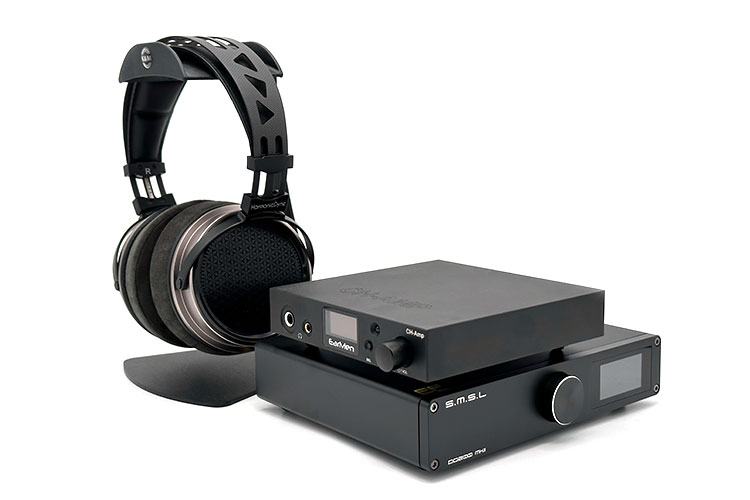
At the end of the chain, I used two vastly opposing tuned headphones. I’ve been enjoying the Audio-Technica ATH-ADX5000 for its revealing properties, while the Thieaudio Wraith is for more casual sessions.
Coming from the Wraith and jumping to the ATH-ADX5000 showed the latter has better clarity with stricter tonality. This demonstrates that the D200 MKII has the chops to tame even a $2,000 set of headphones without any major drawbacks.
I considered the Wraith for more casual sessions since it has a slight scoop in the midrange that lets me listen to the DO200 MKII longer. The additional thickness though in tuning is a mixed bag depending on the song sometimes placing a hit on accuracy.

SELECT COMPARISONS
SMSL DO100
TECHNICAL
Released in 2022, the much cheaper DO100 shouldn’t be criticized for inside are two fairly popular chips from ESS, the ES9038Q2M. The DO100 is designed in a dual DAC setup like the DO200 MKII differing only in chipsets where two ES9068AS can be found in the latter.
Another surprising aspect is that the THD+N and dynamic range of the two units are nearly identical. Measurements aside, the DO200 MKII already updated its XMOS USB module coming from the second-generation XU-216 of the DO100 to the latest gen.
DESIGN
If the DO300 and DO200 MKII won’t be mistaken as siblings, the DO100 did take a slight turn. If there’s a correlation, it’s the curved edges around the aluminum chassis that the DO100 uses to its advantage by stretching a flush tempered glass panel across the face for a downplayed modern look.
The DO200 MKII has a slightly brusquer image as it confidently showcases four screws in front missing in the cohesive display of the DO100. Exposing more metal, the DO200 MKII instead brings in sophistication with the use of a much better volume knob and a full-color IPS screen.
PERFORMANCE
While I was volume matching the two, one immediate thing I heard is the extra air and depth the DO200 MKII has over the DO100. Getting into more details, there’s a clear jump in resolution that users will appreciate when they splurge on the beefier DAC.
Not only will the subtleties in the low-end be easier to dissect, but there is also more substance to each tap while the DO100 remains simple and easy to forget. I don’t want to hurt the DO100 too much but even with simpler bass lines it sounded rounded and blurrier.
I sense a passing sense of similarity in the tonality of the two, especially with the same string passages I listened to with the DO200 MKII. Noticeably tighter and leaner, the higher-end DAC is still the one that gives a more pristine twang.
Vocals also sounded a bit more forward in the DO100. The difference between subtleties between the two though is not night and day.
In the review of the DO100, I did mention that it has a slight upwards tick in energy in the upper midrange. Compared to the DO200 MKII, the DO100 transitions better sans the thinner timbre of the other.
The size and energy of instruments are not very even in the DO100 with the bass meshing much more easily with its neighbors. This is not as much of a problem with the DO200 MKII, painting it as the more composed of the two.
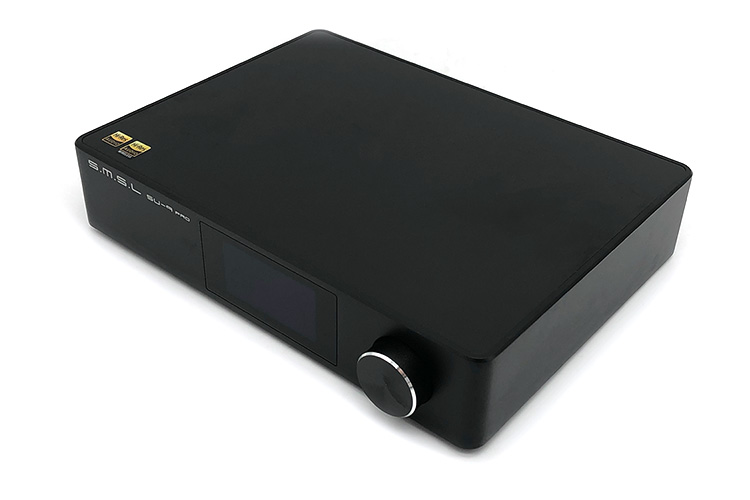
SMSL SU-9 PRO
TECHNICAL
For 30 bucks more, the SU-9 Pro on paper is a more technically advanced and superior solution. Just like what I’m saying earlier, spec chasers will probably salivate over the current ES9039MPRO 8-channel flagship of ESS and other performance upgrades on the SU-9 Pro like the higher dynamic range and op-amp count to name a few.
When using it daily, more casual users won’t notice any difference since the DO200 MKII is just as user-friendly with playback controls. It also has a bigger chassis that not only asks for more attention but it fits behind a long list of IO.
DESIGN
More expensive but physically lighter and more compact than the DO200 MKII, the SU-9 Pro also has a three-piece assembly that is marginally designed neater. One of the things I like across the SU line is their shared low-profile design that hides all the screws from view.
Both units have been installed with the latest display from SMSL so the user experience is pretty familiar. Accessing said display, users can use the volume knob of the SU-9 Pro which has the same likable design as the DO200 MKII made smaller.
PERFORMANCE
An exciting head-to-head clash pitting two devices at pretty much the same price tag, this part is what I was looking forward to the most.
Taking time to check the pros and cons of each, the SU-9 Pro threw the opening punch as it unwrapped a synth beat with a deeper and slightly larger presence. The SU-9 Pro also showed off the muscle of its newer chip with a more resolving delineation between notes.
Guitars on the SU-9 Pro are steelier while the DO200 MKII has a slightly gentler impression. It is to be noted that it is not easily noticeable but the SU-9 Pro is giving me more spatial cues when listening to a piano ballad.
The DO200 MKII isn’t stunned just yet as it remained composed focusing where it counts. Its wallop is exceptionally performed to be a nice accompaniment to the vocal region.
Unexpectedly, what impressed me the most is with violins since both returned exceptionally different results and the question left to the listener to answer. Here, the SU-9 Pro sounded passionate and emotional while the DO200 MKII went rawer in its expression yet gracefully not too dry.
Finally, with soundstage, some quick differences as they are very few and very hard to detect.
The SU-9 Pro on occasion had an easier time retaining far notes and has a broader profile with bass presence for a more engaging feel. While with a clapping audience, the DO200 MKII beat the SU-9 Pro in accomplishing a grander and more holographic scene.

SMSL SU-10
TECHNICAL
Another dual DAC chip setup from SMSL, the SU-10 proudly declares it is harnessing all sixteen channels of its dual ES9038PRO. But even if the DO200 MKII may be using a lower-end ES9068AS, it does even up since it has the same XMOS chip, playback compatibilities, and inputs.
One of the exciting reasons to upgrade to a SU-10 is its two beefy linear power supplies separating it from the pack. There are two power supplies not just to even out the number but to separate the flow of electricity between the digital and analog circuits.
DESIGN
Elevating the SU-10 literally are feet with golden accents that separate it from the usual pro-looking black designs of SMSL. With a tight tolerance all around, the SU-10 feels higher end considering as well that it weighs a little less than 2kg.
With the same simple layout in front only trading the places of the volume and screen, the SU-10 is just as simple to operate. The only obvious upgrade here is the slightly slicker turning volume wheel designed without the silver chamfer of the DO200 MKII.
On the business side of things, the bigger real estate does give allowance for the inputs and outputs to breathe. While the DO200 MKII doesn’t look crowded, once the IO gets used up, the extra room available on the SU-10 is more than welcome.
PERFORMANCE
The DO200 MKII sounds duller when comparing the thump and reverberation of the two. There is less sub-bass extension, and the mid-bass is exchanging some weightiness for clarity and resolution.
Listening to stringed instruments on both is elegantly sounding and crisp. The SU-10 only adds that extra layer of emphasis on each note protecting each pluck to be distinctly precise.
It comes as no surprise that the dynamics of the DO200 MKII felt lacking when playing a busy rock song. The SU-10 returned top-notch precision in retrieving subtle variances in instrument vigor complemented by a much better resolution.
The SU-10 unlike the SU-9 Pro easily sounded more spacious than the DO200 MKII. I am also pleased with the less rigid placement of the SU-10 even with its tighter and cleaner resolution that would suggest otherwise.
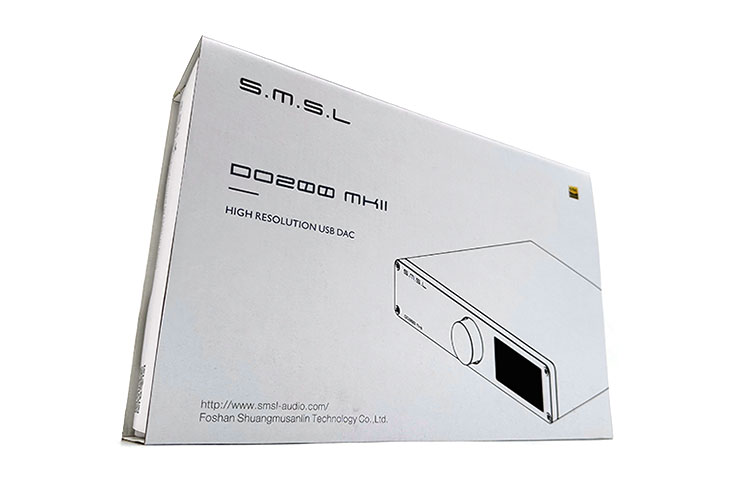
OUR VERDICT
The DO200 MKII is a great example of a device built with a lot of self-confidence. SMSL probably believe they’ve built the original DO200 too advanced for its time and messing up with its internals for its second generation would be a waste.
I partially agree because the DO200 MKII is very high achieving for its price. My reservations though are there since let’s not forget that SMSL themselves and other manufacturers have increasingly populated this space and to be left behind in the battle could cost an arm and a leg.
At least, we get an updated screen and USB module so it can somehow be identified with other newer releases from SMSL. Plus, those considering getting one will get access to a very convenient list of inputs at the back.
SMSL DO200 MKII TECHNICAL SPECIFICATIONS
- DAC: 2 x ES9068AS
- THD+N: 0.00008%
- Dynamic Range: 129dB (XLR); 125dB (RCA)
- Input: USB / Optical / Coaxial / Bluetooth / I2S / AES/EBU
- Output: RCA / XLR
- Playback: 32bit/768kHz PCM; DSD 512
- Bluetooth: BT5.0
- Power Consumption: 5W
- Weight: 1.2kg
Sharing is caring!